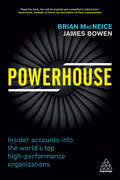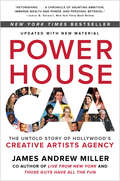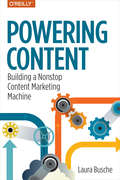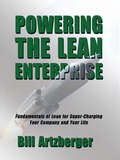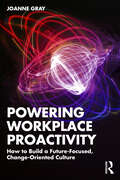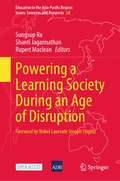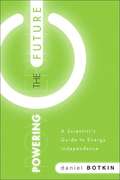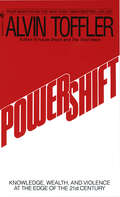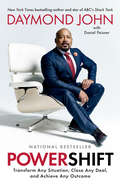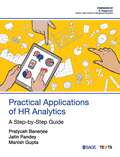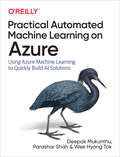- Table View
- List View
Powerhouse Principles
by Donald J. Trump Jorge PerezThe #1 private developer in the U.S., Jorge Pérez reveals his billionaire secrets for power investors.BR> Known as the King of Condominiums and the Steven Spielberg of Real Estate, top developer Jorge Pérez reveals his principles for achieving success in even the toughest real estate market through a clear, step-by-step process. Pérez specifies effective business tactics that will lead to evergreen profits, including: ? Key points to smart investing ? Cardinal rules for picking and building property ? Commandments on negotiating the best deal ? Valuable tips on securing equity ? Steps for successfully selling property Finally, Pérez explains how to manage and grow investments over the long term. Emphasizing the importance of staying flexible in an ever-changing market, Pérez offers personal anecdotes, key business philosophies, and top insider methods to inspire and motivate any investor or entrepreneur to achieve the ultimate success in real estate.
Powerhouse: Insider Accounts into the World's Top High-performance Organizations
by James Bowen Brian MacneiceWhy are the New Zealand All Blacks the best rugby team in the world? How does the Kirov Ballet produce generation after generation of exceptional ballerinas? How did Southwest Airlines evolve from being an idiosyncratic Texan airline to become one of the most successful businesses internationally? How does the Finnish School Education System deliver great results by breaking conventions? Powerhouse uncovers the performance secrets of some of the most impressive organizations around the world and reveals the key principles they have in common to enable any business to raise their own bar. To understand what makes these organizations great, MacNeice and Bowen have conducted immersive and personal research; investigating their culture, interviewing their leaders and observing their everyday practice. Despite this diverse range of seemingly contrasting industries - business, sport, technology, finance, the arts - each of these successful institutions share a common bond: they are world-class industry leaders and have repeatedly outperformed their competition. Powerhouse explores what lessons can be learnt from these organizations to provide a unique and in-depth analysis of how enduring high performance can be developed.
Powerhouse: The Untold Story of Hollywood's Creative Artists Agency
by James Andrew Miller<P>An astonishing--and astonishingly entertaining--history of Hollywood's transformation over the past five decades as seen through the agency at the heart of it all, from the #1 bestselling co-author of Live from New York and Those Guys Have All the Fun. <P>The movies you watch, the TV shows you adore, the concerts and sporting events you attend--behind the curtain of nearly all of these is an immensely powerful and secretive corporation known as Creative Artists Agency. Started in 1975, when five bright and brash employees of a creaky William Morris office left to open their own, strikingly innovative talent agency, CAA would come to revolutionize the entertainment industry, and over the next several decades its tentacles would spread aggressively throughout the worlds of movies, television, music, advertising, and investment banking. <P>Powerhouse is the fascinating, no-holds-barred saga of that ascent. Drawing on unprecedented and exclusive access to the men and women who built and battled with CAA, as well as financial information never before made public, author James Andrew Miller spins a tale of boundless ambition, ruthless egomania, ceaseless empire building, greed, and personal betrayal. It is also a story of prophetic brilliance, magnificent artistry, singular genius, entrepreneurial courage, strategic daring, foxhole brotherhood, and how one firm utterly transformed the entertainment business. <P>Here are the real Star Wars--complete with a Death Star--told through the voices of those who were there. Packed with scores of stars from movies, television, music, and sports, as well as a tremendously compelling cast of agents, studio executives, network chiefs, league commissioners, private equity partners, tech CEOs, and media tycoons, Powerhouse is itself a Hollywood blockbuster of the most spectacular sort. <P><b>A New York Times Bestseller</b>
Powering Content: Building a Nonstop Content Marketing Machine
by Laura BuscheYour new product is ready to launch and you’re itching to tell potential customers all about it. But how do you make your message stand out above all the noise and marketing clutter? Take the guesswork out of content management with this hands-on guide. You’ll learn how to produce and manage powerful content pieces that speak directly to customers and compel them to respond.Author Laura Busche walks you through content strategies and tactics drawn from business, design, and psychology insights. Packed with examples and exercises, this book teaches you how to tell your story with engaging copy, potent images, and striking design—all carefully orchestrated through well-oiled production management. Solopreneurs, startups, marketing managers, and execs will learn 10 Essential Steps to Content Success, with deep dives into:Content strategy: understand your audience, choose and prioritize channels, and find your brand’s core themes, voice, and toneContent creation: craft an engaging experience with content formats and copywriting formulas and templatesContent management: organize, delegate, and supervise tasks; optimize the content production process to reuse successful patterns
Powering Europe: Russia, Ukraine and the Energy Squeeze
by Rafael KandiyotiThe crisis in Ukraine and the Russian annexation of Crimea have prompted the United States and the European Union to examine their energy options. While Europe's dependence on Russian natural gas supplies looms large as a major liability for Europe, Russia's dependence on the $100 billion income from gas exports may deal Europe a stronger hand. Seeking clarity about the current conflict and its energy implications - and responding to the urgent need to critically analyze Europe's short-to-medium term prospects for safely and reliably sourcing future energy imports from sources other than Russia - this book examines the major elements of the European energy equation, contextualizing them within the disorderly breakup of the Soviet Union, post-Soviet developments in Eastern Europe, and the current geopolitical topography of the continent. Accessible and jargon-free, this book asks how and why Ukraine has emerged as the cockpit of a geopolitical contest that has been festering for nearly two decades, and offers insight into the view from Moscow. Finally, it examines Europe's energy options outside of Russia, assessing each not only in terms of technical feasibility and possible lead-time, but also, crucially, in terms of the added costs and geopolitical implications of altering supplies and suppliers, ranging from the continental United States to West Africa to the Eastern Mediterranean to Turkmenistan and possibly even Iran.
Powering Social Change
by Community Wealth VenturesEssays and case studies on nonprofit business techniques based on the concept of community wealth.
Powering Social Enterprise with Profit and Purpose: The Tandem Hybrid
by Scott Boyer Jeremy Gudauskas Mike HamelTrail-blazing social entrepreneurs are tackling the world’s most pressing problems that government, business, or charity have failed to solve. They are creating businesses with a primary mission of social change. Scott Boyer is one such social entrepreneur. This 28-year veteran of Big Pharma left a six-figure salary to start OWP Pharmaceuticals and the ROW Foundation. This commercial business and non-profit organization exist in a symbiotic relationship we call a "tandem hybrid social enterprise." This model combines a multimillion dollar business with a foundation that’s on track to become the largest funder of projects serving people with epilepsy and associated psychiatric disorders in the world. The tandem hybrid incorporates the principles learned by Scott and others for building a truly unique social enterprise from the ground up; one that is: Driven by a compelling social mission Financed by commercial success Structured to retain control Scalable and sustainable for the long haul Powering Social Enterprises With Profit And Purpose offers a detailed blueprint that has proven commercially and philanthropically successful and that can be replicated in most business sectors.
Powering Social Enterprise with Profit and Purpose: The Tandem Hybrid
by Scott Boyer Jeremy Gudauskas Mike HamelTrail-blazing social entrepreneurs are tackling the world’s most pressing problems that government, business, or charity have failed to solve. They are creating businesses with a primary mission of social change. Scott Boyer is one such social entrepreneur. This 28-year veteran of Big Pharma left a six-figure salary to start OWP Pharmaceuticals and the ROW Foundation. This commercial business and non-profit organization exist in a symbiotic relationship we call a "tandem hybrid social enterprise." This model combines a multimillion dollar business with a foundation that’s on track to become the largest funder of projects serving people with epilepsy and associated psychiatric disorders in the world.The tandem hybrid incorporates the principles learned by Scott and others for building a truly unique social enterprise from the ground up; one that is: Driven by a compelling social mission Financed by commercial success Structured to retain control Scalable and sustainable for the long haul Powering Social Enterprises With Profit And Purpose offers a detailed blueprint that has proven commercially and philanthropically successful and that can be replicated in most business sectors.
Powering The Lean Enterprise: Fundamentals of Lean for Super-Charging Your Company & Your Life
by Bill ArtzbergerIn Powering the Lean Enterprise, author Bill Artzberger introduces basic lean rules and principles in a variety of simulated cases drawn from his personal experiences as a lean coach, trainer and manager. In each instance, Bill presents a different scenario for implementing lean technologies. “The goal of lean is to identify and eliminate non-essential and non-value-added steps in the business process in order to streamline operations, improve quality and gain customer loyalty,” states Bill. “Implementation of lean technologies for a significant number of prestigious Fortune 500 as well as smaller companies has netted larger profit margins, higher quality products and services, improved employee engagement, increased customer satisfaction, and lower operating costs. The ROI for lean is off the charts.” In this book you will learn about: Lean Thinking, Lean Mindset, Lean Culture, The 4 Lean Rules & 5 Lean Principles, Choosing Lean, Lean Transformation Roadmap, Lean Leadership, Five Common Lean Pitfalls & How to Avoid Them, Kaizen Workshops, Daily Improvements - Kata
Powering Up Canada: A Short History of Power, Fuel, and Energy from 1600
by R.W. SandwellA comprehensive history of energy sources - from wood to nuclear - and their role in shaping Canadian society.
Powering Workplace Proactivity: How to Build a Future-Focused, Change-Oriented Culture
by Joanne GrayEmpowering, customizable, and backed by organizational research, this book introduces the PROACTIVE work design model and diagnostic tool to help organizations create optimal conditions for proactivity at work to flourish.The pressures and expectations of 21st-century life have led to short-term, reactive behavior in the workplace, however, long-term business success relies on proactive behavior, which is self-directed, future-focused, and change-orientated. But proactivity does not occur in a vacuum – it is a complex, social process heavily affected by contextual and situational factors. With its distinct and flexible design model, this book solves the problem of ‘how’ to create the optimal conditions for proactivity at work to flourish, and to drive sustainability and competitive advantage. And its diagnostic feature recognizes that readers are time-pressured and may already be doing some things well within their organizations, so it offers a solution to their problems without having to read the entire book before they can start making a difference. Uniquely, this book recognizes how important it is for leaders to shape the work environment and to be a positive role model to stimulate employee proactive behavior.Intended as a practical resource, this book provides a range of evidence-based tools and techniques and includes insightful case studies that will be useful for leaders, managers, HR professionals, OD practitioners, and consultants who want to drive proactive behaviors within their organizations.
Powering a Learning Society During an Age of Disruption (Education in the Asia-Pacific Region: Issues, Concerns and Prospects #58)
by Rupert Maclean Shanti Jagannathan Sungsup RaThis open access book presents contemporary perspectives on the role of a learning society from the lens of leading practitioners, experts from universities, governments, and industry leaders. The think pieces argue for a learning society as a major driver of change with far-reaching influence on learning to serve the needs of economies and societies. The book is a testimonial to the importance of ‘learning communities.’ It highlights the pivotal role that can be played by non-traditional actors such as city and urban planners, citizens, transport professionals, and technology companies. This collection seeks to contribute to the discourse on strengthening the fabric of a learning society crucial for future economic and social development, particularly in the aftermath of the coronavirus disease.
Powering the Future: A Scientist's Guide to Energy Independence
by Daniel B. BotkinThe future of civilization depends upon the continuous availability of sufficient energy. But we're approaching the practical limits of some of the energy sources we depend upon most. What should be done? Few issues are as controversial. In Powering the Future, a leading scientist cuts through the controversy, presenting the facts about our energy needs, desires, and supplies and the environmental and human effects of obtaining and using energy. Dr. Daniel B. Botkin objectively assesses the true prospects, limitations, costs, risks, dangers, and tradeoffs associated with every leading and emerging source of energy, including oil, natural gas, coal, hydroelectric, nuclear, wind, solar, ocean power, and biofuels. Next, Botkin addresses the energy distribution system, outlining how it currently works, identifying its inefficiencies, and reviewing options for improving it. Finally, Botkin turns to solutions, offering a realistic, scientifically and economically viable path to a sustainable, energy-independent future: one that can improve the quality of life for Americans and for people around the world. THE FUTURE OF FOSSIL FUELS-- What can we realistically expect from oil, gas, and coal? WILL ALTERNATIVE ENERGY SOURCES REALLY MATTER? Running the numbers on solar, wind, biofuels and other renewables. MUST WE ALL WEAR SWEATERS AND LIVE IN CAVES? The right role for efficiency--and why energy minimalism isn't the solution. WHERE WE CAN START--AND WHAT WILL HAPPEN IF WE DON'T? No magic bullet, but there are sensible, realistic solutions.
Powering the Lean Enterprise: How to Streamline Operations, Improve Quality, and Gain Customer Loyalty
by Bill ArtzbergerThe goal of Lean is to identify and eliminate nonessential and non-value-adding steps in business processes to streamline operations, improve quality, and gain customer loyalty. Implementation of Lean technologies for many prestigious Fortune 500 companies as well as smaller companies has netted larger profit margins, higher-quality products and services, improved employee engagement, increased customer satisfaction, and lower operating costs. The return on investment regarding Lean initiatives has been stellar. This book introduces basic Lean rules and principles in a variety of simulated case studies drawn from the author’s professional experiences as a Lean coach, trainer, and manager. In each instance, the author presents a different scenario for implementing Lean technologies.In this book, you will learn about:– Lean thinking– Lean mindset– The 4 Lean rules and 5 Lean principles– The Lean transformation roadmap– Lean leadership– Five common Lean pitfalls and how to avoid them– Kaizen workshops– Daily improvements and Kata
Powerlines: Words That Sell Brands, Grip Fans, and Sometimes Change History (Bloomberg #13)
by Steve ConePowerlines, the exceptional slogans that people remember long after the campaign ends, stand out from the barrage of marketing messages consumers face each day. A product, service, company, candidate, or an organization with a powerline outshines the competition every time. Steve Cone, author of Steal These Ideas!, reveals the secrets to contemporary marketing's biggest mystery: how to conjure the phrase that will make a product irresistible and memorable. This book restores the lost art of creating killer slogans to its proper place: front and center in every campaign. Drawing on examples of great and not-so-great lines from marketing, politics, and popular culture, Cone provides an irreverent, intelligent, and insightful primer on a singularly important aspect of brand building. Silver Medal Winner, Advertising/Marketing/PR/Event Planning Category, Axiom Business Book Awards (2009)
Powers, Possessions and Freedom: Essays in Honour of C.B. Macpherson
by Alkis KontosCrawford Brough Macpherson has been teaching at the University of Toronto for some forty years, building an international reputation through his identification and critique of possessive individualism as a core concept in Western liberal democratic theory. The essays brought together here from eminent scholars all over the English-speaking world are independent statements on the issues that preoccupy Macpherson - powers, possessions, and freedom, the central problems in political theory. They are arranged in a historical sequence, touching on the thought of Hobbes, Locke, Rousseau, Marx, and Macpherson himself, and facing with vigour and originality the dilemmas of liberal-democratic and Marxian theory of social and political life. It concludes with an explication by the editor of the inner parable of Durrenmatt's play, The Visit, as a profound critique of capitalism, and with a bibliography of Macpherson's published work.
Powershell Core 6.1 Cookbook: Leverage command-line shell scripting to effectively manage your enterprise environment
by Jan-Hendrik PetersThis book will be for windows administrators who want to enhance their PowerShell scripting skills to the next level. System administrators wanting to automate common to complex tasks with PowerShell scripts would benefit from this book. Prior understanding on PowerShell would be necessary.
Powershift: Knowledge, Wealth, and Power at the Edge of the 21st Century
by Alvin TofflerAlvin Toffler&’s Future Shock and The Third Wave are among the most influential books of our time. Now, in Powershift, he brings to a climax the ideas set forth in his previous works to offer a stunning vision of the future that will change your life. In Powershift, Toffler argues that while headlines focus on shifts of power at the global level, equally significant shifts are taking place in the everyday world we all inhabit—the world of supermarkets and hospitals, banks and business offices, television and telephones, politics and personal life. The very nature of power is changing under our eyes. Powershift maps the &“info-wars&” of tomorrow and outlines a new system of wealth creation based on individualism, innovation, and information. As old political antagonisms fade, Toffler identifies where the next, far more important world division will arise—not between East and West or North and South, but between the &“fast&” and the &“slow.&” In Powershift, Alvin Toffler has formulated the deepest, most comprehensive synthesis yet written about the civilization of the twenty-first century. It is one of the most important books you will ever read. Praise for Powershift &“[A] sweeping synthesis . . . by placing the accelerated changes of our current information age in the larger perspective of history, Mr. Toffler helps us to face the future with less wariness and more understanding.&”—The New York Times Book Review &“An insightful guide to a bewildering present and a frightening future . . . thought-provoking on every page.&”—Newsday
Powershift: Transform Any Situation, Close Any Deal, and Achieve Any Outcome
by Daniel Paisner Daymond JohnThe bestselling author and star of ABC&’s Shark Tank reveals how to master the three prongs of influence: reputation, negotiation, and relationships. Have you ever wanted to make a big change in your life but weren&’t sure where to start? In Powershift, Daymond John shares the answer. To take control of your destiny and drive the change you want to see, you need to lay the groundwork so you&’re prepared to seize every opportunity that comes your way. And that means mastering • Influence—make an impression: Develop a reputation that highlights what you stand for. • Negotiation—make a deal: Hone a win-win negotiating style. • Relationships—make a connection last: Nurture those connections you make along the way. Through never-before-told stories from his life and career, Daymond shares the lessons that got him to where he is today: from how he remade his public image as he transitioned from clothing mogul to television personality, to how he mastered the negotiation strategies that determine whether deals are won or lost &“in the tank,&” to his secrets for building long-lasting—and profitable—relationships with founders and brands. Throughout the book, some of the world&’s most successful personalities reveal how they shifted their power in meaningful ways: Kris Jenner on determining your value: &“You don&’t have to go ask somebody else for permission. You have the power to be able to stick to your guns and demand your worth.&” Mark Cuban on finding and understanding your why: &“Time is the one asset we don&’t own, we can&’t buy, and we can never get back.&” Pitbull on tapping into your inner power: &“A lot of people feel that to be powerful is to exude strength. I think it&’s the total opposite. To be powerful is to be powerless. It&’s when you give everybody what you got.&” Whether you&’re an innovator working to turn your big idea into a reality, a professional looking to land a major promotion, or a busy parent trying to find more time to focus on what&’s really important to you, Daymond shows you how to shift your power and energy towards positive change.
PraDigi Open Learning: Transforming Rural India
by John J-H Kim Malini SenPratham is a non-governmental organization, focusing on high-quality, low-cost and replicable interventions to address gaps in the Indian education system. Co-founder Madhav Chavan is interested in using technology for education but differed in the way it is used in schools in India. He believes that technology allowed flexibility and non-linearity in exploring knowledge while the school classroom is based on a rigid and linear path of learning textbook lessons for the sake of examinations. Keeping this in mind, Chavan designs a digital initiative, PraDigi Open Learning, to improve basic numeracy and literacy skills among children in rural India. Electronic tablets pre-loaded with content is distributed in a few villages to help increase children's engagement with learning. Self-directed peer group learning is encouraged. The tablets trigger the children's curiosity. Post-COVID 19, when children are not able to attend class because of the lockdown, Chavan wonders how PraDigi Open Learning can be scaled and aligned with school education to ensure uninterrupted learning.
Praava Health: A New Model for Bangladesh
by Michael ChuLaunched in Dhaka, Bangladesh, in 2015, Praava Health ('Praava') delivered high-quality in-clinic primary and specialist care, backed by its own high quality diagnostic laboratories, imaging and pharmacy. Praava was founder Sylvana Sinha's response to what she saw as a broken healthcare system in one of the world's most populous countries, unable to provide efficient, reliable medical attention to the majority of its population. Centered on the patient, it had a flagship state-of-the art medical center in Dhaka, and digital channels, including Bangladesh's first patient app, telemedicine, and e-pharmacy. Behind all this was a highly qualified medical, technical and management team, made possible by equity investments of $11.1 million. But raising funds had been a difficult and arduous process, even as Praava's revenues were growing at around 20% a month. As Sinha proceeded to plan her next steps in Series B fundraising, she wondered if there were modifications that she needed to consider. Were there any changes --- in the Praava business model, in the financing structure or in her messaging --- that would allow her to break through in the capital markets?
Practical A/B Testing: Creating Experimentation-driven Products
by Leemay NasseryWhether you're a catalyst for organizational change or have the support you need to create an engineering culture that embraces A/B testing, this book will help you do it right. The step-by-step instructions will demystify the entire process, from constructing an A/B test to breaking down the decision factors to build an engineering platform. When you're ready to run the A/B test of your dreams, you'll have the perfect blueprint.With smart, tactful approaches to orchestrating A/B testing on a product, you'll quickly discover how to reap all the benefits that A/B testing has to offer - benefits that span your users, your product, and your team. Take the reins today, and be the change you want to see in your engineering and product organizations.Develop a hypothesis statement that's backed with metrics that demonstrate if your prediction for the experiment is correct. Build more inclusive products by leveraging audience segmentation strategies and ad-hoc post analysis to better understand the impact of changes on specific user groups. Determine which path is best for your team when deciding whether to go with a third-party A/B test framework or to build the A/B testing platform in-house. And finally, learn how to cultivate an experimentation-friendly culture within your team.Leverage the A/B testing methodology to demonstrate the impact of changes on a product to your users, your key business metrics, and the way your team works together. After all, if you aren't measuring the impact of the changes you make, how will you know if you're truly making improvements?
Practical Applications of HR Analytics: A Step-by-Step Guide
by Pratyush Banerjee Jatin PandeyA comprehensive introduction to the know-how of HR analytics and its role in optimizing HR decision-making and driving organizational performance. In today's technology-driven world, HR analytics is pivotal to measure, express and take focused HR decisions. Practical Applications of HR Analytics equips readers with the required tools and techniques to effectively identify, capture and utilize the vast amount of available data in making better informed business decisions. The text is lucid and packed with practical illustrative examples, hands-on exercises and datasets. It is an invaluable resource for management students and HR professionals who want to translate the benefits of HR analytics into practice, thus paving the way for evidence-based human resource management. Key Features: • Practical understanding of a range of open-source statistical GUI software. • Focus on both descriptive and predictive analytics in HR. • Chapter opening vignettes, industry examples and real-world case studies on application of HR analytics in organizations. • Supplementary exercises and soft copy of datasets provided on Google Drive Link to facilitate hands-on training.
Practical Aspects of Rape Investigation: A Multidisciplinary Approach, (Practical Aspects of Criminal and Forensic Investigations)
by Robert R. Hazelwood Ann BurgessThe latest sixth edition of Practical Aspects of Rape Investigation is a fully updated, comprehensive volume on investigative procedures and victim-oriented case management for professionals assisting victims of rape and sexual assault.Rape and sexual assault cases have a devastating societal impact, particularly among the vulnerable populations most affected, including women, children, the elderly, minorities, and members of the LGBTQ+ communities. Such cases are all too common and, unfortunately, the number of cases continues to rise. As such, the need for a current reference on the topic has never been more pressing.Edited by Ann Wolbert Burgess—the subject of Hulu’s 2024 documentary series Mastermind: To Think Like a Killer, and an internationally recognized researcher and pioneer in the assessment and treatment of victims of trauma and abuse—this book covers various topics contributed to by experts from a broad range of fields. Leading academics, researchers, and investigative professionals address the problem of rape and sexual assault holistically, focusing on the core principles of real-world investigative techniques, behavioral profiling, investigative strategies and techniques, social worker involvement, and victimology.When a rape case goes undetected or unreported, a violent offender remains on the streets with the opportunity to reoffend—often repeatedly. Because victims are frequently reluctant to speak out or act in such cases, this book aims to raise awareness and, ultimately, decrease the number of silent victims and improve rape-investigative capabilities and outcomes.Practical Aspects of Rape Investigation, Sixth Edition provides the essential tools and techniques for professionals to best serve, and advocate for, victims. It continues to serve as an invaluable reference for students, legal professionals, and case managers, and as a blueprint for investigators and law enforcement professionals on case management best practices.
Practical Automated Machine Learning on Azure: Using Azure Machine Learning to Quickly Build AI Solutions
by Wee Hyong Tok Parashar Shah Deepak MukunthuDevelop smart applications without spending days and weeks building machine-learning models. With this practical book, you’ll learn how to apply automated machine learning (AutoML), a process that uses machine learning to help people build machine learning models. Deepak Mukunthu, Parashar Shah, and Wee Hyong Tok provide a mix of technical depth, hands-on examples, and case studies that show how customers are solving real-world problems with this technology.Building machine-learning models is an iterative and time-consuming process. Even those who know how to create ML models may be limited in how much they can explore. Once you complete this book, you’ll understand how to apply AutoML to your data right away.Learn how companies in different industries are benefiting from AutoMLGet started with AutoML using AzureExplore aspects such as algorithm selection, auto featurization, and hyperparameter tuningUnderstand how data analysts, BI professions, developers can use AutoML in their familiar tools and experiencesLearn how to get started using AutoML for use cases including classification, regression, and forecasting.

